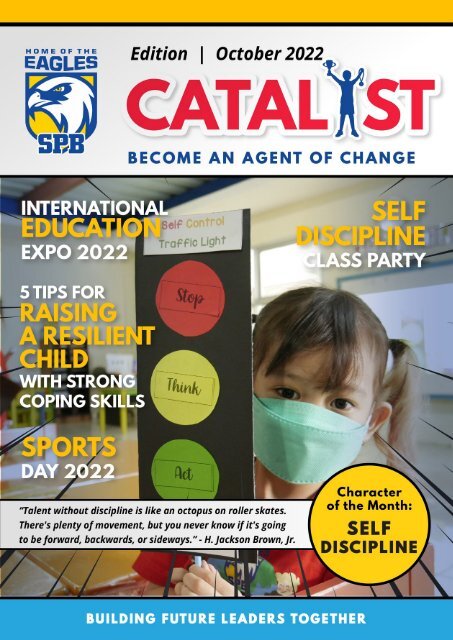CATALYST | October 2022
Monthly insight of student and teacher activities at SPK Sekolah Pelita Bangsa Cirebon
Monthly insight of student and teacher activities at SPK Sekolah Pelita Bangsa Cirebon
You also want an ePaper? Increase the reach of your titles
YUMPU automatically turns print PDFs into web optimized ePapers that Google loves.
CONTENTS<br />
Principal's Message<br />
SPB International<br />
Education Expo <strong>2022</strong><br />
ODA Pendidikan Seni Budaya<br />
Korea + Indonesia<br />
Mental Wellness Seminar:<br />
Mental Health Issues 101<br />
SPORTS DAY <strong>2022</strong><br />
Kindergarten<br />
Self Discipline Party<br />
Student Achievements<br />
2<br />
4<br />
5<br />
6<br />
7<br />
8<br />
<strong>October</strong> <strong>2022</strong> is an exciting and busy<br />
month for staff, teachers, students and<br />
SPB families. The Bhinneka Tunggal Ika<br />
Celebration, the first whole school event<br />
since the pandemic, will be conducted at<br />
the end of this month.<br />
Bhinneka Tunggal Ika Celebration will<br />
celebrate the diversity of arts, cultures<br />
and ways of lives of more than 275 million<br />
Indonesian people who are spread out<br />
from Sabang to Merauke. Bhinneka<br />
Tunggal Ika Celebration embraces the<br />
spirit of Sumpah Pemuda, in which<br />
Indonesian Youth back in 1928 who came<br />
from different background, decided to<br />
set aside all the differences and chose to<br />
unite as one Indonesia.<br />
In addition to celebrate the diversity of<br />
Indonesia, to feel the unity and integrity<br />
of Indonesia and to learn about the many<br />
interesting cultures and facts from all<br />
of Indonesia, this event is a platform<br />
for students to practice and sharpen<br />
many important life skills, namely,<br />
collaboration, communication, social and<br />
problem solving skills. We are thrilled<br />
with all the support we have received<br />
preparing this event, and cannot wait<br />
to see our students rise up and proudly<br />
perform and present their learning.<br />
Please also enjoy this issue with practical<br />
tips to raise a resilient child with strong<br />
coping skills and and an article about how<br />
to support anxious kids.<br />
I am looking forward to meeting you on<br />
Bhinneka Tunggal Ika Day.<br />
SPOTLIGHT ON<br />
9<br />
Warm Regards,<br />
Regina Elisabeth T. B.Sc, M.Ed<br />
The History of Cirebon<br />
Railway Station<br />
13<br />
(Executive Principal)<br />
5 Tips for Raising a Resilient Child<br />
With Strong Coping Skills<br />
14<br />
Anxious kids? Teach them to take off<br />
their anxiety goggles<br />
Book Corner<br />
16<br />
18<br />
is SPB new magazine in digital format<br />
– Save the earth<br />
– Easy acess & archive, get the previous edition in a finger tip<br />
– Colorful & clean template design<br />
– More interactive! Click to view video<br />
Location : SPB Arena<br />
1
HIGHLIGHT<br />
HIGHLIGHT<br />
Video<br />
2 3
HIGHLIGHT<br />
HIGHLIGHT<br />
4<br />
5
NURSERY CORNER<br />
KINDERGARTEN CORNER<br />
6<br />
7
ACHIEVEMENTS<br />
PROFESSIONAL AT SPB<br />
8<br />
Click link below for share your child achievements:<br />
https://bit.ly/SPB_Achievement 9
PRIMARY NUSANTARA CORNER<br />
Video<br />
ADVERTISEMENT<br />
13
SPB PARENTING TIPS 1<br />
5 Tips for Raising a<br />
Resilient Child With<br />
Strong Coping Skills<br />
By Nayanika Guha<br />
Being able to face adversity and emerge<br />
more resilient is something we all can<br />
learn to do. Children too!<br />
Our best bet is to equip our children with<br />
healthy coping skills. Resilient children<br />
can stand tall in the face of challenges<br />
and use problem-solving skills to forge<br />
ahead. They are confident, curious, and<br />
independent. Here are some ways you<br />
can foster resilience and build coping<br />
skills in your child.<br />
Strike a balance between supporting and<br />
overprotecting<br />
One of the most challenging things as a<br />
parent is to see your child struggle with<br />
something. How can we step back and let<br />
children safely struggle? Struggling with<br />
a problem stretches your child's mind,<br />
creating new connections and helping<br />
them develop solutions. It also nourishes<br />
creativity and innovation in getting the<br />
job done, one way or another. Try letting<br />
your child do it themselves first.<br />
Instead, tell your child they have to<br />
try and finish the task without help.<br />
Then, if they continue struggling, they<br />
can ask for help. Even when you help,<br />
say, "let's do it together," which signals<br />
your support while still embracing selfsufficiency.<br />
Being supportive shows<br />
your child you have their back while<br />
being overprotective hinders new skill<br />
development.<br />
Help your child identify emotions and<br />
appropriate responses to emotions<br />
Behind every behavior is an emotion.<br />
Recognizing these emotions, labeling<br />
them, and then working through them<br />
helps children develop skills to deal with<br />
similar situations in the future. Help<br />
children learn various emotions with an<br />
emotions chart — one popular version<br />
uses emojis. Ask your child to identify<br />
how a fictional character might be feeling<br />
at any given moment, or give voice to<br />
your feelings. Saying things like "I am<br />
sad because I had a disagreement with<br />
my friend" or "I am afraid of spiders"<br />
allows your child to connect emotions<br />
to behaviors. when to compromise,<br />
when to keep out of the way and when<br />
to present a united front. Knowing when<br />
to take each approach takes practice<br />
and depends on the issues at hand, your<br />
parenting styles and your individual<br />
values.<br />
Ensure your child knows the appropriate ways to respond<br />
to the emotions they feel. Instead of scolding your child<br />
when they’re angry, guide them by helping them identify<br />
their feelings to build resiliency. If a child is angry about<br />
something, use a time-in. Be with your child in that difficult<br />
moment and identify what you see. Never push a child to<br />
talk; stay "in the moment" until they are in a stable place to<br />
talk.<br />
Encourage children to solve their problems<br />
Our children face many daily issues, from our little ones<br />
learning how to tie their shoelaces to our teens dealing with<br />
a breakup. Replace rescuing with coping skill education to<br />
help them learn to help themselves. Provide a coping skills<br />
box with a list of activities or items to help soothe strong<br />
emotions. Being able to solve their problems not only helps<br />
build coping skills and resiliency, but also increases selfconfidence<br />
and self-esteem.<br />
Model the skills and behavior you want children to exhibit<br />
Your child may not always listen to what you have to<br />
say, but they are always observing and learning from<br />
your actions. Observational learning refers to learning by<br />
observing others, retaining the information, and replicating<br />
later. We see this most often in toddlers. Think of how a<br />
child imitates funny faces you make at them.<br />
Show children how to sequence the emotional regulation<br />
steps to ensure they embrace the emotion, label it,<br />
and move forward appropriately. Co-regulation models<br />
appropriate identification and response to emotions while<br />
helping to maintain balance for your mental wellness.<br />
Help children identify their threshold and set their<br />
boundaries<br />
If you sense your child becoming overly frustrated, identify<br />
physical symptoms you are seeing and offer solutions<br />
supporting their struggle. Ensure children are in a balanced<br />
emotional state before being asked to complete a difficult<br />
task independently. It’s essential to set up the environment<br />
to embrace a healthy struggle so children feel a sense of<br />
accompaniment even when they cannot find a solution<br />
independently.<br />
Children with strong emotional regulation skills can identify<br />
coping skills to help them bring balance to their world. They<br />
use activities that foster calm and balance. Parents who<br />
co-regulate with their children promote independence in<br />
problem-solving and in working through difficult moments.<br />
14<br />
Source:<br />
15
SPB PARENTING TIPS 2<br />
SPB PARENTING TIPS 2<br />
16<br />
Anxious kids? Teach<br />
them to take off their<br />
anxiety goggles<br />
by Dr Jodi Richardson<br />
Do you find it hard to focus on the present?<br />
There’s always so much to do and plan<br />
for as parents. It’s no wonder our minds<br />
wander so much. But to think that we<br />
spend nearly half of our lives thinking about<br />
things other than what we are doing means<br />
there’s an awful lot we’re missing out on.<br />
When we’re fully engaged with what’s<br />
happening , there’s so much to experience.<br />
Bringing our thoughts back to the present<br />
moment can be like landing them on a<br />
calm, quiet, relaxed island in the midst of<br />
stormy seas.<br />
When our minds wander to troubling<br />
thoughts, we end up experiencing pain and<br />
suffering at times when we’re often warm<br />
and dry, fed and watered, safe and secure.<br />
Like when we’re in bed. Snug and relaxed<br />
in our comfy beds, our doona keeping us<br />
warm (or a sheet to keep us cool), with a<br />
lovely soft place to lay our heads. Could we<br />
be more content in that moment? If only<br />
our minds would stay with us!<br />
It’s the same with our kids. It’s often at<br />
the end of the day when they’re no longer<br />
engaged in activities that they begin to think<br />
and worry.<br />
Their minds are far away from the reality of<br />
being safe in their rooms with loving family<br />
close by but they are sick with worry about<br />
future events.<br />
Sometimes thoughts are so ‘sticky’ it’s hard<br />
to let go<br />
It’s hard being a wandering minds back<br />
to the present when we’re so swept up in<br />
our worries. It takes practice to notice a<br />
wandering mind, gently ‘unhook’ from the<br />
thought and return our attention to the<br />
present moment. That’s the practice of<br />
mindfulness. Notice, unhook, return, repeat.<br />
Put your head where your hands are<br />
A lovely woman at one of my retreats told me<br />
her grandma’s favourite saying was “put your<br />
head where your hands are” meaning think<br />
about what it is you’re doing while you’re<br />
doing it. That’s smart!<br />
Noticing our thoughts are wandering and<br />
bringing our attention back to what we’re<br />
actually doing is a skill, which gets easier<br />
with practice. It’s a powerful skill to teach<br />
kids as it to gives them perspective and<br />
importantly, the space they need for positive<br />
change.<br />
Viewing the world through anxiety goggles<br />
When our kids feel anxious they look at what’s<br />
happening around them through ‘anxiety<br />
goggles’. It’s like when you look through a<br />
pair of glasses with red lenses and everything<br />
looks red. Take them off and all is clear again.<br />
What if we could help our kids to take off<br />
their anxiety goggles and learn to look at their<br />
thoughts rather than from them? It would<br />
bring them such relief.<br />
Creating a lovely space between our kids and<br />
what they’re thinking<br />
We can help our kids do this by developing<br />
their metacognition (thought-noticing) skills.<br />
That way, when their minds wander to their<br />
worries and troubles they can notice they’re<br />
actually ‘lost in thought’ and not really<br />
experiencing the events they are thinking<br />
about. It would help them to ‘unhook’ from<br />
their daydreaming and importantly, bring their<br />
minds back to the present moment.anxiety<br />
goggles and learn to look at their thoughts<br />
rather than from them? It would bring them<br />
such relief.<br />
Thought-noticing<br />
This is a wonderful skillset which helps our<br />
kids to manage their mental health. When<br />
kids tune into their thinking, they immediately<br />
distance themselves from it. Rather than<br />
being lost in the thoughts that are making<br />
them feel anxious, they can mentally step<br />
back and see the thought for what it is. Just<br />
another thought that comes and goes like all<br />
the ones before and all the ones to come.<br />
Teaching thought-noticing to kids<br />
There are many ways to teach thought<br />
noticing to kids. Look at these ideas like a<br />
‘Choose your own adventure’. Start where you<br />
like and go in any direction that feels right for<br />
you and your family. If the idea you try isn’t<br />
quite the right fit, choose another!<br />
Do you hear what I hear?<br />
Lay down comfortably side by side and<br />
spend 2 minutes listening for any sounds you<br />
can hear, near or far. When you’re finished,<br />
compare what you heard and open<br />
a discussion about how our minds often<br />
wander away with our thoughts. Kids will<br />
know this as ‘daydreaming’. Share how your<br />
mind wandered and invite your child to do the<br />
same.<br />
Tell me more<br />
Day-to-day conversations are great for<br />
thought noticing. It’s about asking the right<br />
questions. Here are some examples to get the<br />
thought noticing conversation started: “Can<br />
you tell me more about why you think that?<br />
Why do you think you got so upset when we<br />
had to go straight home? Why do you think<br />
you’re putting off doing your homework?<br />
How will you know when your painting is<br />
complete?”<br />
Name your mind<br />
If we get our kids to give their minds a<br />
name, we open up opportunities to ask them<br />
different questions. For instance, if your child<br />
name’s his/her mind Sam. You can ask your<br />
child what Sam is thinking. This encourages<br />
your child to step back and take a helicopter<br />
view of him or herself.<br />
Post-meltdown reflection<br />
In the aftermath of a meltdown or outburst,<br />
when calm has returned and your child or teen<br />
has moved on, take some time to ask why<br />
he/she got so upset over what happened?<br />
Ask questions like “what did your mind say<br />
to make you feel upset?” for younger children<br />
or “can you tell me what you were thinking<br />
that made you feel so angry, frustrated,<br />
disappointed etc.?” for older kids.<br />
Developing metacognition or ‘thinking about<br />
thinking’ skills fosters self-regulation among<br />
children. As contributing to children’s mental<br />
health and happiness, metacognition helps<br />
kids be more successful, more resilient and be<br />
able to problem-solve because they are less<br />
likely to get caught up in their worries.<br />
And remember, your GP is a great place to<br />
start if you have any issues with your kids<br />
that you’d like reassurance or advice on. Make<br />
time for a chat.<br />
Source:<br />
17
18<br />
BOOK CORNER
Connect with us<br />
(Click The icons)<br />
Sekolah Pelita Bangsa<br />
@sekolahpelitabangsacirebon<br />
info@pelitabangsa.com<br />
0231-208887<br />
0897 8407 888<br />
www.pelitabangsa.com<br />
Sekolah Pelita Bangsa<br />
Inspiring Minds Podcast<br />
Taman Cipto Blok A1<br />
Kav 6, Cirebon – 45131<br />
Pindai QR Code ini<br />
untuk menyimpan alamat kami
















